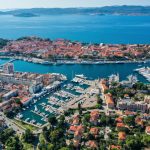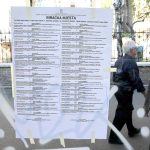A late-afternoon bura sends a cool gust cutting down Zadar’s main thoroughfare, kalelarga. A handful of wanderers and two tourists roam the long, desolate stretch of cobblestone dotted by well-lit stores. Nearly all are empty.
A Yamamay touting fancy undergarments with no one to sell them to. A Swarovski shop’s lonely cashiers stand idly by their registers. A new-ish watering hole called “La Bodega” holds its doors open to reveal empty bar stools.
Cafes, the stoic holdouts in every Croatian town, keep their outdoor seating available for one final warm spell before Christmas.
Welcome to Zadar in its post-summer hibernation, a six-to-eight month period of desolation and doldrums. When infamous “white paper” covers storefronts and obstructs glass-encased restaurants that otherwise resemble aquariums. Go ahead, try to saddle up for a meal somewhere.
That new restaurant you heard offers dynamite cuisine? It’s closed.
How about the old staple of the local scene which has spent decades consistently serving Dalmatian classics? Nope.
Well, at least the fast food joint must… Bupkis.
The few locals left spend the first hours of every morning fervently crossing off grocery lists then trudging off to work. Then home. A brave few remain outside, meandering past now-empty spaces where commerce used to take place.
Cafes remain the lone outliers, open year-round. After all, someone must offer the remaining Zadrani and students a place to congregate and complain about the lack stuff to do.
Thanks to all the hype and bustling summers, Zadar seems to be a Croatian destination on-the-rise. Yet the empty streets tell a more opaque tale.
Zadar’s Fervent ‘Yes’ To Tourists
Like much of Dalmatia, Zadar milked the engorged tourism cow until it backfired in myriad ways.
The historic peninsula at Zadar’s core is hemorrhaging residents, seeing its population plunge by about 25 percent over the last decade. The few remaining make due in the face of living expenses inflated by tourism.
Now, like much of the coast, Zadar is looking for a way out of a boom-bust tourism cycle tied to mother nature’s fluctuations; all while also reversing depressing demographic trends and the growing sense that Zadar is a great place to visit — but not call home.
It’s first attempt: a glitzy new ad campaign featuring robust young folks running, climbing, jumping, all heavily breathing while subjecting themselves to strenuous exercise in scenic locations.
The ad also includes fleeting images of Zadar’s previous target demographic: happy couples taking selfies, families at play, eating dinner, or enjoying a brief respite by the Sea Organ. In the aggregate, those scenes feel drowned out by the sweaty fitness fanatics peppering the ad.
Because Zadar’s new target demographic presumably has zero intention of briefly ditching their Fitbit goals during their vacation, nor does it care if the narrator of the promotional video can actually pronounce the town’s name.
It ends with a clarion call to “Say yes,” a zealous demand that tourists give all of themselves to enjoying Zadar as it already is.
Say yes? Locals are desperately fighting the urge to say, “No.”
Why The Ghosts Came To Town
Empty storefronts and desolate streets may be a sign of a bigger, more problematic trend: a mass exodus sucking dry the last remnants of a year-round customer base.
“We have high payrolls, electric bills and other expenses, as well as rent,” said Stipe Kneževic, president of the local small business owners association, in an interview with Zadarski List.
Simply put: there aren’t enough locals to spend during the off-season, leading revenues to fall well short of the cost of staying open. For many business owners, it’s smarter to close up shop and minimize losses, then eagerly wait for the hordes to return in late spring. Knežević’s group asked the City of Zadar to lower rents on all municipally owned properties rented out to locals, to no avail.
Other businesses stay open on a shoestring budget, staffed at a bare minimum then seeking capable ringers to fill out staff during the summer.
Good, experienced employees are hard to find, Knezevic added. Many employers end up investing time and energy into training employees, only to have them leave at the end of the year regardless. “Only an idiot would let a good worker leave,” he added.
It all accumulates into a bizarre Catch-22: Zadar’s small businesses close because there’s no one to work or spend money; citizens leave because even if they could make a decent living they don’t have anywhere to spend.
A round table aimed at reviving Zadar’s historic core convened on Wednesday, featuring a gaggle of tourism honchos and local academics.
Zadar’s new tourism director, Mario Paleka, was short on answers at the round table. Many expected to be wow-ed by the same presentation which reportedly landed him the job despite lackluster credentials.
Yet Paleka’s contribution was limited to a few milquetoast promises of big plans and declaring Zadar needed to exist for its citizens — not tourists.
City council member Mladen Malta was the only participant to offer some advice, albeit well-worn, suggesting an increase in available parking, festivities and events need to be spread more evenly throughout the year, and perhaps luring a famous fashion brand to the historic center would all help.
In the end, the group reportedly spent most of their time finding elaborate ways to describe Zadar’s desolation, without listing specific solutions.
Moderator and sociologist Sven Marcelić reportedly claimed a large number of living spaces — perhaps too many — have been rejiggered to accommodate tourists and not locals. The result, after the summer is over, is a high-priced ghost town.
“The number of stores is dropping, and economic activity outside of ‘the season’ doesn’t exist,” Marcelić said.
The dearth of accommodations means students studying in Zadar have to pay rents comparable with the pricey tourism season.
“Zadar is fast becoming one of the most expensive cities to study in in Croatia,” Marcelić said. “The growth in private accommodations didn’t follow the increase in tourism, all while citizens turned into second class citizens.”
Finding A Solution
Even Zadar’s new “Say yes” campaign wasn’t universally welcomed. The nearly three-minute opus left some feeling neglected, with officials from the local municipalities of Preko and Ugljan sending an open letter asking why certain parts of the county were wholly ignored.
“Considering the camera’s lens is very expensive, why doesn’t it have a wide angle?” the letter reads. “It apparently doesn’t, since it can’t film the entire county.”
Zadar does have some hope to hang onto — internal bickering and mass emigration not withstanding. Its airport recently crossed the 600,000-passenger threshold this year for the first time ever. Lonely Planet included the town on its 2019 “Best in Travel” list of places to visit — though it ranked second-to-last. (Locals probably weren’t happy to see Serbia’s Novi Sad ranked No. 3).
Some parts of the region are spreading events out, or adding new ones. Pag, an island whose winter offerings are curtailed by its legendary bura, will have its own version of Advent this year to rival Zadar’s own light version of the Zagreb staple.
Yet rejiggering the summer festival schedule and adding more parking barely address the soup-to-nuts problems facing many Zadrani. They’d gladly say yes to the town, region and even Croatia if it offered a stable, fulfilling job with a salary capable of covering ever-growing living expenses.
Until then, “Yes” will be a word Zadar rarely hears from its residents.
Follow the latest on Zadar’s tourism, check out TCN’s dedicated page here.








